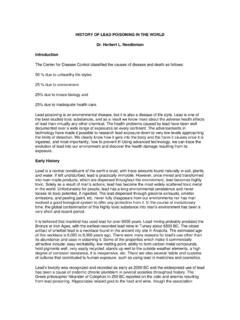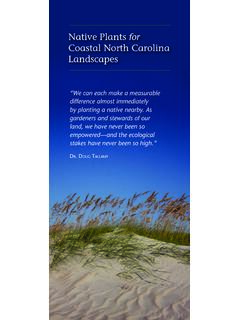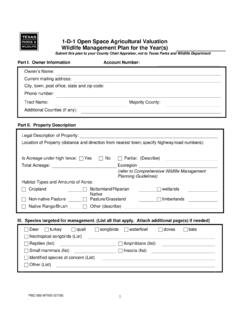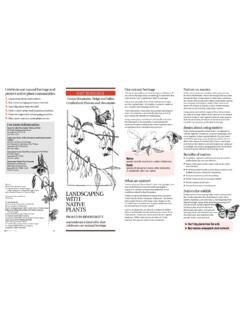Transcription of Medicinal Plants at Risk - Center for Biological Diversity
1 Medicinal Plants at Risk A Native Plant Conservation Campaign Report Nature s Pharmacy, Our Treasure Chest: Why We Must Conserve Our Natural HeritageBy Emily Roberson,Native Plant Conservation Campaign DirectorMarch 2008 Layout & Design:Anna Mirocha & Julie MillerFront Cover:Black cohosh in flower and ginseng berries photos byJeff flowers courtesy p e c i a l t h a n k s t o t h o s e w h o p r o v i d e d f u n d i n g , i n p u t , p e e r r e v i e w, a n d o t h e r assistance during the development of this h e N a t i ve P l a n t C o n s e r va t i o n C a m p a i g n i s a p r o j e c t o f t h e C e n t e r f o r B i o l o g i c a l Diversity . The Center works through science, law, and creative media to secure a future for all species, great or small, hovering on the brink of for Biological Box 710 Tucson, AZ of ContentsExecutive : habitat Destruction, Bioprospecting, and of Naturally Derived And courtesy Kathryn A.
2 Lynch and Eric T. JonesMEDICINAL Plants AT RISK NATURE S PHARMACY, OUR TREASURE CHESTPage 1 Medicinal Plants AT RISK NATURE S PHARMACY, OUR TREASURE CHESTE xecutive SummaryMedicinal Plants grow naturally around us. Over centuries, cultures around the world have learned how to use Plants to fight illness and maintain health. These readily available and culturally important traditional medicines form the basis of an accessible and affordable health-care regime and are an important source of livelihood for indigenous and rural populations. Increasingly, Medicinal species that reside in natural areas have received scientific and commercial attention.
3 In the United States, of the top 150 prescription drugs, at least 118 are based on natural sources. A child suffering from leukemia in 1960 faced a 10 percent chance of remission; by 1997, the likelihood of remission had been increased to 95 percent thanks to two drugs derived from a wild plant native to Madagascar. But we still know little about the treasure trove inhabiting our wild places. As of 1995, less than 1 percent of all tropical plant species had been screened for potential pharmaceutical Medicinal Plants receive increased scientific and commercial attention, there is increasing pressure on the wild plant populations from which most Medicinal Plants are harvested. Overharvesting has placed many Medicinal species at risk of extinction. Commercial exploitation has also sometimes led to traditional medicines becoming unavailable to the indigenous peoples that have relied on them for centuries or millennia.
4 For all of these reasons, the study and conservation of Medicinal plant (and animal) species has become increasingly urgent. The accelerating loss of species and habitat worldwide adds to this urgency. Already, about 15,000 Medicinal plant species may be threatened with extinction worldwide. Experts estimate that the Earth is losing at least one potential major drug every two years. The land abounds in these natural remedies and to classify the Plants , give their names and describe their properties, the presence of a botanist would be required. It is certain that many illnesses are cured by people and they have their remedies for everything, many quite effective. For this reason not a few prefer their herbs and roots to our unguents and salves. Reply by a missionary at Mission San Antonio as to what knowledge the natives had of medicines (Geiger and Meighan, 1976) Medicinal Plants AT RISK NATURE S PHARMACY, OUR TREASURE CHESTMEDICINAL Plants AT RISK NATURE S PHARMACY, OUR TREASURE CHESTC enter for Biological Diversity Page 2 Organizations and governments throughout the world are rising to meet this challenge.
5 Through the Global Convention on Biological Diversity , the Convention on International Trade in Endangered Species, and non-governmental organizations such as those working to develop an International Standard for Sustainable Wild Collection of Medicinal and Aromatic Plants (ISSC-MAP), scientists and policymakers are proposing new procedures and policies to safeguard our remaining Medicinal treasures in the wild so that they can protect this and future generations. Goldenseal in flower Photo by Jeff 3 Medicinal Plants AT RISK NATURE S PHARMACY, OUR TREASURE CHESTMEDICINAL Plants AT RISK NATURE S PHARMACY, OUR TREASURE CHEST drugs, at least 118 are based on natural sources: 74 percent come from Plants , 18 percent from fungi, 5 percent from bacteria, and 3 percent from vertebrate species such as snakes or frogs (Ecology Society of America, 1997).
6 The life-saving benefits of this treasure trove are enormous: According to the National Cancer Institute, at least 70 percent of new drugs introduced in the United States in the last 25 years are derived from natural sources (Steenhuysen, 2007). Plant-derived anti-cancer drugs such as taxol, first isolated from the Pacific yew, save at least 30,000 lives per year in the United States (Daily, 1997). Thanks to two drugs derived from alkaloids of Madagascar s rosy periwinkle, the likelihood of remission for a child suffering from leukemia increased by 85 percent between 1960 and 1997 (Daily, 1997; Botanic Gardens Conservation International, 1996). New compounds, such as one recently discovered in a plant in Madagascar, are likely to provide novel antibiotics and help curb the epidemic of antibiotic-resistant diseases (Wang et al.)
7 , 2006). New classes of anti-viral drugs derived from Plants such as star anise provide unprecedented hope for combating potential epidemic viral diseases such as flu (Laurance, 2005). Drugs to fight life-threatening diseases such as diabetes, HIV, and diarrhea and even substances to protect crops from slugs are being developed from Plants , microorganisms, amoebae, and other species from African countries such as Egypt, Somalia, Libya, and Gambia (Barnett, 2006). This planet s spectacular web of life supplies countless gifts to humanity. Healthy wild ecosystems clean the water we drink and produce the air we breathe, the foods we eat, the medicines that cure and protect us, and the materials that form our shelter and clothing. Wild ecosystems moderate our climate and mitigate natural hazards such as hurricanes, floods, and landslides.
8 They even protect us from pests and diseases for example, species such as spiders literally filter insects from the air, just as plant roots filter disease organisms and pollutants from streams and other water sources. Individuals, communities, and economies depend on intact diverse native wildlands for all of these irreplaceable services. The Medicinal species that reside in natural areas have received increasing scientific and commercial attention in recent years. Worldwide, between 50,000 and 80,000 flowering Plants are used medicinally (IUCN Species Survival Commission, 2007; Marinelli, 2005). In the United States, of the top 150 prescription IntroductionBlack cohoshPhoto courtesy Plants AT RISK NATURE S PHARMACY, OUR TREASURE CHESTC enter for Biological Diversity Page 4 Medicinal Plants AT RISK NATURE S PHARMACY, OUR TREASURE CHESTA lthough this report focuses on Medicinal plant species, it is worth noting that the above-referenced estimate is confined to medicines and so excludes losses of new foods, fibers, and other potential tools that may fight famine, create housing, or generate other benefits to local communities, societies, and economies.
9 Our ignorance becomes increasingly dangerous as the rates of loss of Plants , fish, wildlife , and habitat accelerate (Marinelli, 2005). Each species lost to extinction represents not only the potential loss of life-saving cures for diseases such as cancer or AIDS, but also the loss of possible protein- or vitamin-rich foods or more productive and stable crops. Bloodroot flowering near Ithaca, New YorkPhoto courtesy Kathryn A. Lynch and Eric T. JonesOf course, the use of wild species to cure and resist disease is nothing new. In China, Medicinal plant use goes back at least 4,000 years, and healers have used more than 5,000 plant species (Tuxhill, 1999). More than 80 percent of South Asia s billion people have no access to modern health care; they rely instead on traditional medicine using native species.
10 In fact, many indigenous and local communities are immense reservoirs of traditional knowledge that can benefit biotechnology, agriculture, pharmaceutical development, and health care. Our ability to use wild resources to prevent disease and improve health is not dependent on humans alone. The stability of our supplies of food, fiber, and other crops is threatened by pests, diseases, climate change, and other ever-changing stresses. According to the Ecology Society of America (1997), society s ability to maintain crop production depends on compounds and genes derived from wild relatives of animal and plant crop species. The extraction of genetic resources from the world s so-called library in the wild has recently accounted for annual increases of at least 1 percent in agricultural productivity, equivalent to about $1 billion in revenues (Ecology Society of America, 1997.)
















